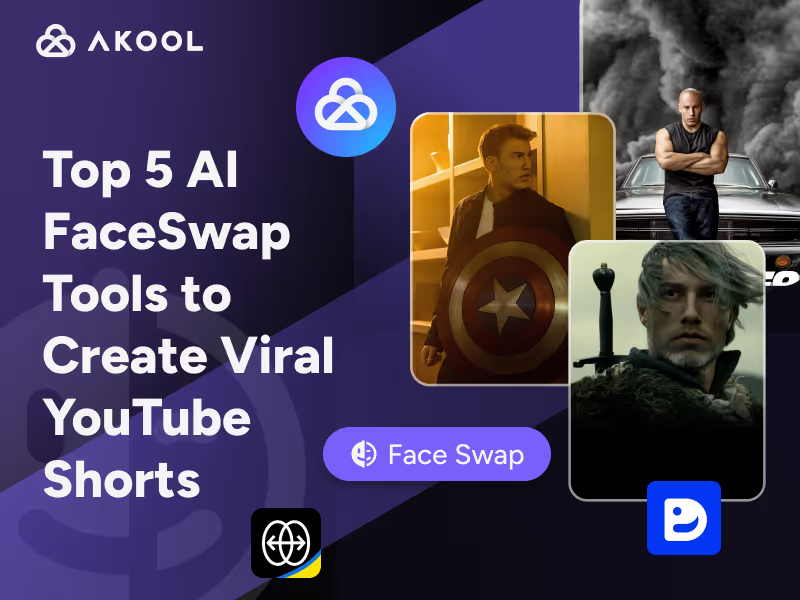AI face swap technology is revolutionizing film and digital content creation – enabling what is essentially “zero-cost” actor replacement in video production. Instead of reshooting scenes or hiring lookalikes, creators can now digitally replace one performer’s face with another, saving significant time and money in post-production. From Hollywood movies to trending YouTube Shorts, this tech empowers content creators to seamlessly change faces and unlock new creative possibilities. Below we rank the top 5 face swap AI tools of 2025 including Akool, DeepSwap, Reface, Faceswap and MyHeritage – detailing their key features, ideal use cases, and any limitations – to help you choose the right solution.
1. Akool — Hollywood-Grade Face Swap Engine
Akool’s advanced AI system uses deep feature decoupling to achieve film-quality real-time face swaps, capturing subtle facial movements and blending lighting in dynamic videos. It seamlessly integrates the swapped face’s micro-expressions and shadows, effectively redefining the industry standard for “AI face swap” realism.

Key Features:
- Live Motion Retargeting: Real-time capture of the source actor’s facial muscle movements (blinks, lip sync, expressions) to drive the swapped face with precision. This ensures the AI-generated face mirrors every nuance of the original performance.
- Biometric Shadow Fusion: Akool’s engine automatically matches the target scene’s lighting angles and skin tones, so the inserted face blends naturally into the video environment. Highlights, shadows, and color tones are adjusted for a seamless composite.
- 4K Temporal Consistency: Supports up to 4K resolution output with strict frame-by-frame consistency. The AI stabilizes the face swap over time, eliminating flicker or “shimmer” between frames and maintaining smooth 60fps motion for professional-quality video.
- Ethical Watermarking: Every face-swapped video includes an invisible digital watermark embedded in the footage. This proactive measure allows future identification of AI-generated content, helping prevent malicious misuse while remaining imperceptible to viewers.
Use Cases: Akool is built for high-end productions and enterprise use. Filmmakers can use it to reshoot scenes digitally – for example, swapping in a late actor’s face to preserve a role without expensive VFX or body doubles. Businesses leverage Akool for localized marketing videos (e.g. a CEO’s face speaking multiple languages) and live presentations. Social media content creators and influencers can even appear as different characters in real time during streams. For instance, a YouTuber could conduct a live Q&A as a digital avatar of a famous figure. Akool’s real-time face swap and avatar capabilities have also enabled virtual events – a presenter can address a global audience “in person” in various languages via an AI face-swapped avatar. The result is Hollywood-grade face replacement accessible for creative projects of all sizes.
2. DeepSwap — Realistic Face Transfer Tool
DeepSwap is a popular online face swap service that leverages a GAN-based engine for high-precision facial replacement. Its self-developed model achieves over 90% similarity in face swaps, and it excels even on difficult angles and non-frontal shots. In other words, DeepSwap produces remarkably realistic face transfers, even when the person in the video isn’t looking directly at the camera.
Key Features:
- High-Fidelity GAN Model: DeepSwap’s AI is built on generative adversarial networks and extensive training data. It achieves 90%+ face similarity, surpassing many open-source models in accuracy. This means the swapped face retains the target person’s identity almost perfectly in most scenes.
- All-Angle Adaptation: The system is optimized for 16+ challenging scenarios, enabling convincing swaps in profiles, low lighting, and other tough conditions. Even if the source face is at an angle or partially obscured, DeepSwap adapts to maintain a lifelike result.
- 4K & Multi-Face Support: Users can generate face-swapped videos in up to 4K UHD resolution for crisp output. It also supports swapping up to 6 faces simultaneously in one video clip – ideal for group scenes or ensemble casts where multiple faces need replacing.
- Blazing Fast, GPU-Powered: Thanks to GPU acceleration, DeepSwap processes video extremely quickly – a 1-minute video can take as little as 10 seconds to swap. This ultra-fast turnaround, combined with no data retention (the service does not save user uploads, protecting privacy), makes it both efficient and secure for creators.
Use Cases: DeepSwap is well-suited for entertainment, social media, and marketing content. Many creators use it to produce parody videos and memes – for example, swapping their own face into famous movie scenes or music videos for a comedic YouTube Short. Its high accuracy on side profiles and varied lighting means filmmakers can trust it for complex shots, like an action scene where a stunt double’s face must be replaced seamlessly. Content creators on TikTok and YouTube leverage DeepSwap to transform into celebrities or fictional characters, effectively breaking language or cultural barriers by face-swapping themselves into locally famous clips. From cosplay videos (putting yourself in an iconic movie role) to quick meme GIFs, DeepSwap’s versatility and speed let users create engaging short-form content in seconds. The platform even markets use cases like virtual try-ons (swapping your face to see how you’d look with different hairstyles or outfits) and fun group edits (swapping faces among friends in a photo).
Limitations: DeepSwap’s service does have a few constraints. Currently, uploaded videos are limited to 10 minutes in length, so longer projects must be split into parts. Extremely fast-moving footage can still pose challenges – in very quick action scenes, the AI might produce minor artifacts or blurring. Also, while basic image swaps are free, full video face swaps require a paid subscription or use of credits. The free tier places watermarks and has limited outputs, meaning serious users will need to upgrade for watermark-free HD results. Overall, DeepSwap is a powerful tool for most projects, but those needing unlimited length or absolute perfection in every frame should be aware of these limits.
3. Reface — Mobile-Optimized Face Swap
Reface is a hugely popular mobile app that brings face swapping to your smartphone. Focused on an easy, one-tap user experience, Reface allows anyone to create face-swap videos, GIFs, and memes in seconds. With over 300 million downloads globally, it’s the go-to face swap app for casual users and influencers looking to generate viral content on the fly.
Key Features:
- One-Tap Face Swaps: Reface makes AI face swapping as simple as taking a selfie. Users can swap their face onto photos or video clips with a single tap – no editing skills required. The app automatically handles alignment and blending, letting you “be anyone” in a few seconds.
- AI Photo Animation: Beyond basic swaps, Reface can animate static photos to make them sing, talk, or blink with its built-in “Revive” feature. You can upload an old photo and have the person’s face come to life (move and lip-sync), which adds a fun, dynamic twist to still images.
- Creative Tool Suite: Reface offers an array of AI-powered creative effects. Users can try gender swap filters, change hairstyles or hair color, morph faces, generate realistic AI headshots, and even use a “future baby” predictor. This all-in-one toolkit means the app is not just for face swapping but for general photo and video face editing and personalization.
- Social Sharing & Daily Updates: The app is designed for social media content creators. It lets you share your face-swapped videos or GIFs directly to platforms like Instagram, TikTok, and YouTube Shorts. New filters, movie scenes, and trending characters are added daily, so users always have fresh material to engage followers and ride the latest meme trends.
Use Cases: Reface shines in the realm of social media and lighthearted content. It’s popular for creating funny memes and challenges – for example, swapping your face into a famous movie clip or onto a celebrity’s photo and posting the result. Many TikTok and YouTube creators use Reface for quick parody videos or to participate in viral face-swap challenges. It’s also a hit among friends for casual fun (ever wanted to put your face on your friend’s favorite GIF?). Because it’s mobile-based, Reface is perfect for on-the-go content creation: an influencer can shoot a selfie and within minutes share a face-swapped skit or reaction meme from their phone. The app has even been used by digital marketers to create engaging promotional clips by face-swapping company mascots or team members into popular meme formats. In short, Reface is all about instant entertainment and creativity for content creators who need speed and simplicity.
Limitations: As a mobile app, Reface is geared towards fun over ultra-realism. The face swaps, while generally convincing on a small screen, may not hold up for professional film-quality needs (some subtle mismatches can occur in complex frames). The free version of Reface is ad-supported and stamps a watermark on outputs; it also limits how many swaps you can do per day. Full access (no watermarks, unlimited swaps, and longer video swaps) requires a Pro subscription. Additionally, Reface’s video clips are typically short – longer or high-resolution video edits are not its focus. Finally, as with any automated app, you don’t have fine control over the outcome (you can’t manually tweak the swap), so results depend on the templates provided. Despite these limits, Reface remains unrivaled for mobile face swap fun and quick content, especially for those willing to pay for the premium features.
4. FaceSwap — Open-Source Face Swap Framework
FaceSwap (the open-source project) is a community-driven, professional deepfake framework. As a free tool available on Windows, Mac, and Linux, it allows enthusiasts and researchers to create highly custom face swap models. FaceSwap doesn’t offer a slick one-click UI like others; instead, it provides a robust foundation to train your own AI for face swapping, giving you full control over the process. This open-source solution has become a staple for AI developers and VFX artists who need maximum flexibility and fine-tuned, high-quality results in their “AI face swap” projects.
Key Features:
- Completely Free & Open-Source: FaceSwap is released under an open-source license and is free to use for anyone. Users can download it from the official website or GitHub and join an active community forum for support. The community frequently updates the software with improvements.
- Cross-Platform & GPU Accelerated: The software runs on Windows, macOS, and Linux, leveraging TensorFlow (and Keras) for its deep learning back-end. It’s optimized for machines with powerful NVIDIA GPUs, which significantly speed up training and conversion. (CPU-only usage is possible but very slow, so a good GPU is recommended for any serious work.)
- Custom Model Training: Unlike one-size-fits-all apps, FaceSwap lets you train your own neural network models for each face swap task. You extract faces from your source and target videos, then train the AI on these faces to teach it how to map one to the other. This training step can produce extremely high-fidelity swaps tailored to your specific characters, especially with enough data.
- Advanced Control & Tools: FaceSwap offers a graphical user interface (GUI) and a command-line mode, with numerous settings to tweak. You can choose different model architectures, adjust masks to refine the swapped area, set training parameters, and even integrate face enhancement tools. Comprehensive guides and tutorials are available for every step (extraction, training, conversion) to help users get the best results. This level of customization means you can push the quality further (at the cost of more effort) than most commercial tools.
FaceSwap is typically used in professional or research scenarios rather than quick consumer content. In the film and VFX industry, artists use FaceSwap (and similar deepfake frameworks) for tasks like stunt double face replacement or de-aging an actor – scenarios where they need absolute control over the outcome and can afford longer development time. For example, the technology behind FaceSwap-style deepfakes was famously used by Lucasfilm to re-create a young Luke Skywalker in The Mandalorian. Indie filmmakers and YouTube creators with technical savvy might use FaceSwap to produce fan edits – e.g. swapping actors in famous scenes or creating mashups – with higher realism than app-based tools can provide. It’s also popular in the AI research community for experimenting with new face swapping techniques, given one can modify the code and models freely. Essentially, content creators who want the utmost quality and don’t mind a learning curve will gravitate to FaceSwap for projects where off-the-shelf solutions fall short.
Limitations: FaceSwap’s power comes with complexity. Setup and usage are non-trivial – users must obtain large datasets of faces and train models for hours or days, which is a barrier for novices. A high-end GPU and lots of memory/storage are practically required to get good results in a reasonable time. Even then, certain challenging cases (very low-light images, extreme angles, or heavy occlusions) might require manual tuning and still produce artifacts like blurriness or slight misalignments. Another major concern is ethical use: because FaceSwap can generate highly realistic deepfakes, it could be misused. The developers note it’s intended for authorized and ethical use only, and using it to create deceptive or non-consensual deepfakes is strongly discouraged (and may be illegal). In fact, FaceSwap includes no built-in usage restrictions or watermarks, so responsibility lies entirely with the user. Finally, unlike paid services, there’s no dedicated support – you rely on community forums for help. In summary, FaceSwap is immensely powerful and free, but demands skill, patience, and robust hardware, and it should be used carefully given the potential for misuse.
5. MyHeritage — Historical Photo Revival Tool
MyHeritage’s Deep Nostalgia feature takes face swapping in a different direction – it specializes in animating old photos rather than swapping faces between live actors. This “historical photo revival” tool uses deep learning to make the faces in still images move and smile. The idea is to bring ancestors and historical figures to life: you upload an old portrait, and the AI generates a short video of that person appearing to turn their head, blink, and grin as if recorded on film. It’s a heartwarming application of face technology that went viral for its ability to resurrect historical faces in a realistic way.
Key Features:
- AI Photo Animation: Deep Nostalgia uses video reenactment algorithms licensed from D-ID to animate faces in still photographs. The tool applies a set of pre-recorded driver movements to your photo, so the person in the image will blink, smile, and tilt their head naturally. Even decades-old black-and-white photos can be animated with surprisingly life-like expressions.
- High-Quality Output: The system automatically enhances and upscales the image before animation to ensure the video comes out clear. The resulting animation is a few seconds of high-resolution video focusing on the face, rendered in color (or the original tone of the photo). The movements are subtle and respectful, mimicking how a person might naturally look around.
- One-Click Simplicity: The feature is available on the MyHeritage website/app and is very easy to use – just upload a photo and hit animate. It detects faces in the photo; if there are multiple people, you can choose which face to animate. The animation is generated in ~10–20 seconds on the cloud. No editing or technical knowledge is needed, making it accessible to all (especially the genealogy community who may not be tech experts).
- Viral Sensation: Since its launch, Deep Nostalgia has processed over 100 million animations and became an internet sensation. Users shared millions of clips of historical figures, ancestors, even vintage artwork brought to life. This widespread use demonstrates the tool’s reliability and the public’s fascination – it was widely covered in media for its “magical yet eerie” quality.
Use Cases: The primary use case is genealogy and family history. MyHeritage intended Deep Nostalgia to let people see their ancestors in motion – for example, you could take a 100-year-old photograph of your great-grandmother and watch her smile at you in a short video. This has an emotional impact and helps younger generations connect with long-past relatives. Museums and educators have also used the tech to animate historical figures (like making a still portrait of a famous person move) as a way to engage audiences. On social media, it sparked a trend of users animating everything from old Hollywood stars to characters in paintings. Content creators jumped on the trend by posting these animations – effectively AI-generated historical “shorts” – to provoke discussion about AI or just delight viewers with a bit of nostalgia. While not a face swap in the traditional sense, Deep Nostalgia opened a new niche for AI in content creation: breathing life into archival images in a way that’s both entertaining and educational.
Limitations: Deep Nostalgia is intentionally limited in scope. It produces silent, head-and-shoulders animations only – there’s no voice or full-body movement, and you cannot direct the expression (it picks from preset gesture sequences). This means all animations have a similar feel (the person will blink and smile gently), which, if overused, can appear unnatural or repetitive. Some users find the effect “uncanny” or even creepy – especially if the source photo was very old or the person is long deceased. MyHeritage has acknowledged this mixed reaction, noting the feature is intended for sentimental use and not to create fake videos of living people. On the technical side, if the photo is extremely low resolution or the face is at a sharp angle, the animation may struggle or look odd (the AI can’t always fill in missing details). Lastly, while you can try a few animations for free, continued use requires a subscription to MyHeritage (the company’s premium plans) once you’ve exceeded the free trial limit. In summary, Deep Nostalgia is a wonderful novelty for specific uses, but it’s not a general-purpose face swap tool – it’s specialized, and its outputs should be viewed as curiosities or heartfelt mementos rather than realistic videos.
In conclusion, AI face swap technology has matured dramatically – whether you’re a filmmaker needing a professional-grade face replacement or a creator looking to spice up short-form videos, there’s a tool tailored to your needs. The Top 5 solutions above each excel in their domain: Akool leads for live, high-end production swaps; DeepSwap offers fast and precise results online; Reface dominates mobile meme culture; FaceSwap empowers the open-source community; and MyHeritage opens a window to the past by animating photos.
As we move through 2025, face swapping is becoming increasingly mainstream and accessible. Among these, Akool stands out for those who want an all-in-one, studio-quality platform – it combines real-time swapping, avatars, and multilingual video capabilities that can elevate content to a new level. If you’re ready to explore the next frontier of video production, it may be time to give Akool’s free trial a spin and see how “Hollywood-grade” face swapping can transform your creative projects. Your imagination is the only limit!






.avif)


.avif)
.avif)